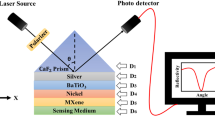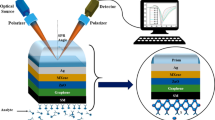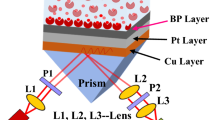Abstract
In the present paper, the design and simulation of a surface plasmon resonance (SPR) Sensor for better sensitivity performance by employing a thin layer of barium titanate (BaTiO3) has been presented. The proposed biosensor is comprised of layers in the following order: Prism–Ag–SiO2/BaTiO3–Au–Analyte. Urine Sample with different glucose levels is used as an analyte here. Monochromatic light of 633 nm is used for the excitation of plasmons in the biosensor. This biosensor would be able to respond for urine samples having the following range of sugar concentration present in non-diabetic person (0–15 mg/dL in the urine sample), and with the diabetic person (0.625, 1.25, 2.5, 5, and 10 g/dL in the urine sample). A comparison is also made with the SiO2 layer (conventional biosensor). On comparison, it is found that using the BaTiO3 layer, provides much lower values of reflectance and can significantly improve biosensor sensitivity up to 180°/RIU. This structure drops the sensitivity with the increase in the thickness of the BaTiO3 layer in the range of 2–7 nm. We also replaced the BaTiO3 Layer that shows lower sensitivity around 120°/RIU. So, it can be said that the BaTiO3 layer enhances the sensitivity of the structure and can detect a very minute change in the variation of the refractive indices of the analyte. This design is directly applicable for the detection of sugar level detection in diabetic and non-diabetic persons.




Similar content being viewed by others
References
Victoria S, Roland H (2020) Surface plasmon resonance (SPR)-based biosensors as instruments with high versatility and sensitivity. MDPI Sensors. https://doi.org/10.3390/s20113010
Pollet J, Delport F, Janssen KPF, Jans K, Maes G, Pfeiffer H, Wevers M, Lammertyn J (2009) Fiber optic SPR biosensing of DNA hybridization and DNA–protein interactions. Biosens Bioelectron 25(4):864–869
Youjun Zeng, Rui Hu, Lei Wang, Dayong Gu, Jianan He, Shu-Yuen Wu, Ho-Pui Ho, Xuejin Li, Junle Qu, Bruce Zhi Gao, and Yonghong Shao, "Recent advances in surface plasmon resonance imaging: detection speed, sensitivity, and portability", De Gruyter | Published online: June 22, 2017, https://doi.org/10.1515/nanoph-2017-0022.
Homola J (2003) Present and future of surface plasmon resonance biosensors. Anal Bioanal Chem 377(3):528–539
Mihaela P, Camelia B (2016) SPR and SPR imaging: recent trends in developing nanodevices for detection and real-time monitoring of biomolecular events. Sensors (Basel). https://doi.org/10.3390/s16060870
Hoang HN, Jeho P, Sebyung K, Moonil K (2015) Surface plasmon resonance: a versatile technique for biosensor applications. Sensors 15:10481–10510. https://doi.org/10.3390/s150510481
Scott Phillips K, Quan C (2007) Recent advances in surface plasmon resonance-based techniques for bioanalysis. Anal Bioanal Chem 387(5):1831–1840. https://doi.org/10.1007/s00216-006-1052-7
Brilliant AP, Agnes Purwidyantriand K-CL (2018) Surface plasmon resonance optical sensor: a review on light source technology. Biosensors MDPI. https://doi.org/10.3390/bios8030080
Xudong F, White IM, Shopova SI, Hongying Z, Suter JD, Yuze S (2008) Sensitive optical biosensors for unlabeled targets: a review. Anal Chimica Acta 620(1–2):8–26
Otto A (1968) Excitation of nonradiative surface plasma waves in silver by the method of frustrated total reflection. Zeitschrift für Physik A Hadrons Nuclei 216:398–410
Shankaran DR, Gobi KV, Miura N (2007) Recent advancements in surface plasmon resonance immunosensors for detection of small molecules of biomedical, food and environmental interest. Sens Actuators B 121:158–177
Homola J, Yee SS, Gauglitz G (1999) Surface plasmon resonance sensors. Sens Actuators B 54:3–15
Markos P, Soukoulis C (2008) Wave propagation. In: From electrons to photonic crystals and left-handed materials. Princeton University Press, New Jersey
Choi SH, Kim YL, Byun KM (2011) Graphene-on-silver substrates for sensitive surface plasmon resonance imaging biosensors. Opt Express 19:458–466
Sharma P, Sharan P (2014) Design of photonic crystal based biosensor for detection of glucose concentration in urine. IEEE J Sensors 15(02):1035–1042
Yong C, Ming H (2012) Review of surface plasmon resonance and localized surface plasmon resonance sensor. In: Photonic sensors, vol 2, pp 37–49
Born M, WOLF E (1980) Principles of optics. Pergamon Press, Oxford
Yadav A, Sharan P, Kumar A (2020) urface plasmonic resonance-based five-layered structure-biosensor for sugar level measurement in human. In: Results in optics, vol 1, p 100002
Sharma P, Sharan P (2014) Photonic crystal-based sensor for detection of high glucose concentration in urine. In: India Conference (INDICOM), 2014 Annual IEEE, pp 1–6
Author information
Authors and Affiliations
Corresponding author
Rights and permissions
About this article
Cite this article
Yadav, A., Sudhanva, S., Sharan, P. et al. Modeling, simulation and computational analysis of plasmonic optical sensor using BaTiO3 in diabetes mellitus. Int. j. inf. tecnol. 13, 2163–2168 (2021). https://doi.org/10.1007/s41870-021-00793-w
Received:
Accepted:
Published:
Issue Date:
DOI: https://doi.org/10.1007/s41870-021-00793-w




